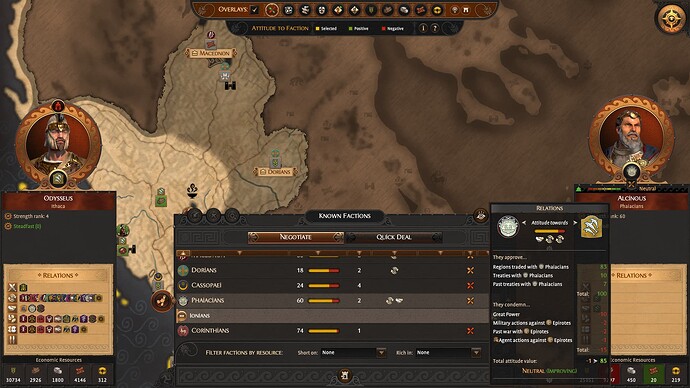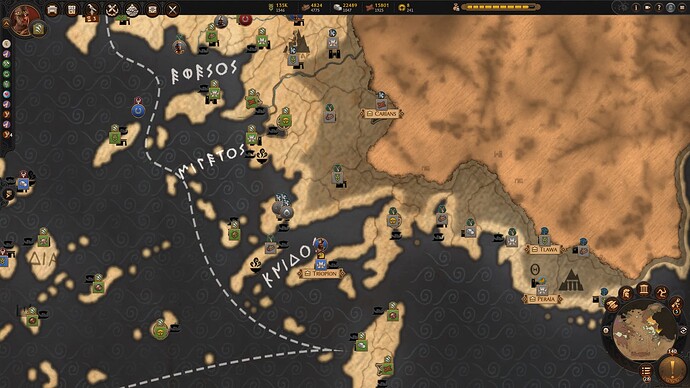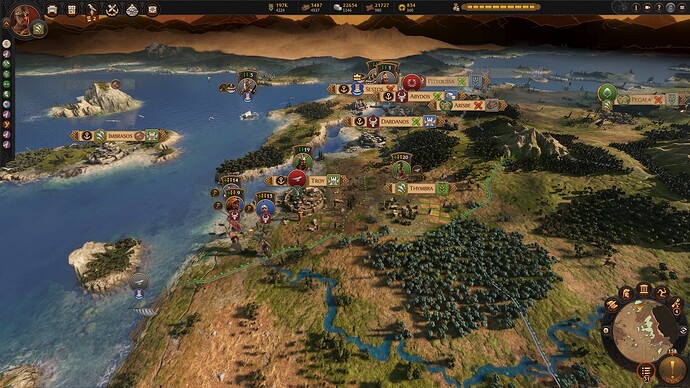Sing me, O Goddess…
If you don’t know what Total War is, it’s a venerable series in the map-painting strategy genre. Its claim to fame is that the turn-based map strategy layer is usually a little lighter and more basic than others of its ilk, but, whenever you get into a battle, the game zooms in and becomes a tactical RTS, with you commanding your blocks of units individually. In this way, you can turn probable defeats into victories with clever execution. I’ve always liked this mix way more than your typical Civ-like.
The series has like I dunno a dozen+ games in it now stretching over eras of history from ancient Rome to the Napoleonic wars. They’ve developed from little 2d sprite guys on a crude 3d map to full featured pretty 3d everything, and the mechanics have slowly evolved over time as well.
My favorite Total War has always been Medieval 2, though I think the most popular one is certainly Rome. Unfortunately Medieval 2 is showing its age and it’s hard to play now without a lot of the QOL developments they’ve made in later titles, it’s due a remake imo (it’s called “Medieval 2” because it itself is a remake of one of the very first TW games, and they’ve done more modern ones for Rome and Shogun as well). They’ve also experimented with more fantasy-based approaches, with units with magical powers and whatnot; there’s a Romance of the Three Kingdoms version, as well as a Warhammer one.
But they made one just for me. They made one… about the Trojan war.
This also means there are now Total War games covering eras from the 12th century BC to the early 19th century. So that’s pretty cool.
Troy Total War is a good example of the modern version of the game. You can actually pick from the beginning whether you get a more grounded historical approach, a really magicked-out wacky version that’s paid DLC, or a middle road where some of the more mythical elements are present with “realistic” interpretations (so like you can recruit a unit of “harpies” but they’re like barbarian women who throw javelins, or “centaurs” who are a really effective mounted archer unit, something that otherwise doesn’t exist in the game). This middle version, which they call like The Truth Behind The Myth or something, was the only one available on release.
I played this game a ton when it first came out a couple years ago, then fell off it as one is wont. But I’ve been reading kid versions of the Iliad and the Odyssey to my kids recently and I got the hankering. So I fell back in and played a campaign as Sarpedon, one of the Trojan mainstays. Kicked enough ass that I came out with some good stories, so I thought… let’s start a new game, and make a thread about it.
Here comes our boy:
Pay attention to that text in the upper right about Odysseus’ unique stuff. This is real important going forward as it practically limits Odysseus to coastal territories which makes your typical clumpy map-painting impossible (although that’s often not a great way to play anyway, as we’ll see). In general it’s a feature of the later TW games to try to differentiate factions more starkly than earlier titles through these one-off, campaign-altering mechanics.
You can see he’s listed as having a Hard starting position. You’re in a corner of the map behind a bunch of relatively powerful factions on the main Peloponnesus. Since you need coastal territory, and it’s not practical to take each bit of coast as you go along even if you were strong enough to take it militarily (more on that later), you’ve got to break out into all the central Aegean islands to really expand, but it’s tough to get there before all the other majors without leaving your soft underbelly exposed to your immediate neighbors. Odysseus has gotta be constantly making moves. Sitting around and consolidating doesn’t work well for him.
Our starting position (with guest seagull). No matter what faction you pick, you always get a start with some jobber faction occupying a chunk of your rightful home province. I recruit a few basic units and go kick those guys in the codpiece.
Their final holdout. Though it says there’s an army there with 4 units to my 12, all settlements have a free garrison that can be used whenever it is attacked, or whenever a friendly army is attacked within reinforcement range on the map. The number of units goes up as the main settlement building levels up, and you can fill one of your building slots with a building that grants extra garrison as well. So this is actually more of an even fight, units-wise.
Attacking a non-walled city. Not all their units are visible yet because they’re far away and behind stuff. You can see I’ve arrayed myself into two wings. Cities have narrow approaches that prevent you from making a full front line, so it’s usually to your advantage to split up on multiple approaches in the hopes of turning one into a flank if you can break the enemy and push through. Unfortunately for these dudes I have more ranged units than them, which kind of forces them to come out of their shells a bit and chase after me.
It doesn’t go well for them.
Something I haven’t mentioned yet is diplomacy, which while basic is really important in this game. The Greeks (Danaans/Achaeans) and Trojans (Pelasgians) have large inherent diplomacy bonuses between themselves and penalties between each other, which really pushes you into making nice with your fellow Greeks (in this case). Eventually, by probably turn 100 at the latest but usually more like 50 or 60, you’re gonna get dragged into an Aegean war with all the Greeks on one side and all the Trojans on the other. It pays to, by that point, have as many friends as possible, and for your friends to be as powerful as possible.
So while in the early game it’s tempting to antagonize one of the big boys if they’re picking on some minor faction whose land you want, that’s usually a bad idea long term. From turn 1 I’ve been making little trade deals with every Greek who I don’t have immediate designs on attacking, to build up long-term relationships that will help out later in the big show. Plus the trade deals themselves can be lucrative, especially as your partners get friendlier. As long as you’re trading them something they really want in exchange for something they really don’t (these are clearly marked with the red and green backgrounds behind the different resources there), you’re making an overall “profit”. Trades of this kind are nearly always worthwhile as long as the other party doesn’t have negative relations with you.
So with the home turf secured, it’s time to figure out where we’re expanding while Odysseus expands his army a bit.
This is the coast to the immediate north of my home islands, a little later after I’m done kicking the ass of the guys who were there first. Along the bottom there you can see all the settlements that are in a province. This is important: owning all a province’s settlements allows you to activate a nice passive bonus for the whole region. There’s also a permanent distinction between capital cities, which is Calydon above, and the other smaller towns. You can see that the towns have way fewer building slots; they also can overall only get to size level 3, whereas capitals can get to 5, unlocking the highest-tier buildings. Plus capitals are capable of building all kinds of things that the towns cannot, including the stuff with province-wide bonuses. What this means is, while having all the towns in a province is very nice, as long as you have the capital it’s ok to be missing some of the towns. But owning just some towns without owning the capital SUCKS. It’s very rarely worth it, although there is a special production building you can put in a town that basically kills growth in exchange for somewhat higher production, which is meant for use when you have just one town in a province with no access to the capital.
This is where Odysseus’ unique feature comes in. You see the little sailing ship icon in the bottom left of Palairos and Astacos? Those identify them as “coastal” cities; all coastal cities have that docks building by default. Odysseus gets bigger bonuses than anyone else when he levels those buildings up. But, if he owns any city that is not coastal, it has NO building slots at all, just the main building in the top left. That’s losing out on 3/4 of each town’s production capacity, and (potentially, at max level 5) 7/8 of a capital city’s. Basically, absolutely not worth it, with the possible exception of grabbing a sneaky inland town or two to finish off an otherwise coastal province. Owning an inland capital city is NEVER worth it for Odysseus.
That brings us back to the screenshot. The only town I actually care about keeping from this war is Lefcas, which belongs to a different province with a coastal capital city. Despite looking like it’s on the coast, the capital Calydon is not coastal - I guess because it’s set on cliffs high above the water so it doesn’t have a port. So Astacos and Palairos, which I took in the war, are useless to me.
What then to do? Well - sell em to the guy who DOES own the capital, because boy, does he want them bad. Cities are by far the most valuable resource to trade and people will fall all over themselves to buy them off you. The brown boar guys, the Aetolians, were roughly my military equals and had no interest in me except for little trade deals. In exchange for Astacos, I got military access (aka permission for my armies to be on their land without them whining about it), a defensive alliance, AND ten turns of some resources. And then they gave me a whole other chunk of resources for Palairos as well.
So now I’ve turned a potential rival into, basically, friends for life. Unless I do some real boneheaded shit the Aetolians will love me forever. They’re also instantly significantly more powerful than their neighbors and therefore a bulwark on my northern border against all the factions on the northern third of the map, which I don’t give a shit about because it’s the Balkans (ok not literally) and not coastal. Well worth a war.
The question is what to do next. The northern Peloponnesus has some juicy all-coastal regions, but they’re ruled by a clutch of Ionians who are all allied together and quickly driving further into the peninsula, which is a war I am not capable of winning. Meanwhile, to the extreme northeast, are these pricks:
That island city, Scheria, is the coastal capital of the province that town Lefca I took is in, so that would be my most juicy target, but that is a large stack sitting on top of a giant 15-unit garrison; the maximum size of a single army is 20 units, so I’d need two big damn armies just to siege that place down, which I can’t really afford, and it would take a long time to do, which I also can’t afford. Also, to my chagrin, we started the game with a non-aggression pact with these guys, and breaking it in order to attack would give me a diplomatic penalty with all other factions that I ALSO can’t afford. That’s a lot of not affording.
Meanwhile, that dove faction on the mainland coast I have noticed in the diplomacy screen has damn near no army (likely due to a war they are in with some further-inland faction). Although the region has two inland towns, one of which is owned by a different faction that it would be pointless to rile, it’s got a coastal capital. While it isn’t the juiciest target economically, these guys are Dorians and don’t have any cultural affinity with me. If I just leave them there they’re going to be a pain allllllll the way in my western ass while I’m trying to push east through the map. So I decide to solve this problem now, while I can.
Setting up to assault a walled city. You can see I’m split in two groups again. If I had tougher units, I’d probably do three, but these guys are too fragile; if you send them in just one or two at a time they’ll freak and break early. I’ve built a couple rams to smash the gates. I’ll use my slingers to screen the ram; once the gates are down, I’ll usually send a tough unit with ladders up the wall as well to attack any squishy units like missile attackers they may have posted up there, while the main melee forces shove through the open gate.
Assaults always result in huge attrition, even if your force is dominant relative to the one inside the walls. I lose a couple weak units entirely and a few more are at a fraction of full strength. But it’s done. Losing units is part of the game; recruitment is fast and maintaining units is expensive anyway. Occasionally in the late game the computer will build death stacks of all elite units, but you’ll more often see a core of a handful of elite units surrounded by easily replaceable swarms. This is an intelligent way to build to keep an effective army while keeping costs down.
While I siege the southern capital and then move onto the inland town, the enemy hero is in the north trying to slap an army together. He thinks he can sneak by me and retake the capital while my back is turned.
It goes poorly for him.
There’s a couple reasons why. Those spears are decent units; they’re probably roughly the equal of my heavy swords (which I have five of, the pentagon icons) and definitely outclass my light swords, which are the guys with circle icons. Plus they outnumber me in melee altogether. In a standup fight I’m dead. But they have basically no missiles, where I have 7 units of cheap slingers.
When you deploy before a battle each side has a zone they can freely arrange their forces in, and there’s always a broad band of no man’s land between. There are, however, special vanguard units that are allowed to set up and deploy in the no man’s land. Odysseus, because he’s a crafty bastard, specializes in these kinds of units - all the light swords can do this, as well as those fancy javelin ambushers with the orange backgrounds, and Odysseus himself.
So I used my heavy swords to create a front line between the forested map edge and a big rock feature. I deployed all my light swords into the no man’s land, hidden in a forest in a giant L formation trap. I also noticed that homeboy had his hero unit deployed off separate from the rest of his force for some dumbass reason - probably to protect him, since I’d used my spy before the battle to assassinate the real hero and this was some jobber replacement. So I deployed Odysseus and his javelin boys basically right in front of him. Hit go, Odi and the Javelins assassinate the enemy hero before the army can really react; then all his fancy heavy spears walk right into my trap, charging facefirst into my line of heavy swords while all my flankers come out and completely envelop them. All while under withering sling volleys. Then of course Odi and the Ambushers push down and javelin them in the rear as well. It was honestly disgusting.
Mission complete.
With my back line secured, it’s time to decide how to expand east. The Ionian situation on the Peloponnesus has only gotten more dire, so I decide to abandon it entirely and start making friends with those guys instead.
Crete, meanwhile, as the biggest island around, is quite juicy territory for me, but my allies have already eaten most of it up (all the towns with blue icons are allied - this is Menelaus, from Sparta, and Diomedes, from Argos, doing work). Damn, I was too slow.
So that can only mean one thing: it’s time for an Aegean campaign.


















































































































































